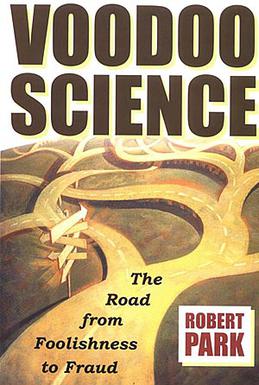In philosophical ethics, the naturalistic fallacy is the claim that any reductive explanation of good, in terms of natural properties such as pleasant or desirable, is false. The term was introduced by British philosopher G. E. Moore in his 1903 book Principia Ethica.
The phrase "correlation does not imply causation" refers to the inability to legitimately deduce a cause-and-effect relationship between two events or variables solely on the basis of an observed association or correlation between them. The idea that "correlation implies causation" is an example of a questionable-cause logical fallacy, in which two events occurring together are taken to have established a cause-and-effect relationship. This fallacy is also known by the Latin phrase cum hoc ergo propter hoc. This differs from the fallacy known as post hoc ergo propter hoc, in which an event following another is seen as a necessary consequence of the former event, and from conflation, the errant merging of two events, ideas, databases, etc., into one.
Confirmation bias is the tendency to search for, interpret, favor, and recall information in a way that confirms or supports one's prior beliefs or values. People display this bias when they select information that supports their views, ignoring contrary information, or when they interpret ambiguous evidence as supporting their existing attitudes. The effect is strongest for desired outcomes, for emotionally charged issues, and for deeply entrenched beliefs. Confirmation bias cannot be eliminated, but it can be managed, for example, by education and training in critical thinking skills.
"Viruses of the Mind" is an essay by British evolutionary biologist Richard Dawkins, first published in the book Dennett and His Critics: Demystifying Mind (1993). Dawkins originally wrote the essay in 1991 and delivered it as a Voltaire Lecture on 6 November 1992 at the Conway Hall Humanist Centre. The essay discusses how religion can be viewed as a meme, an idea previously expressed by Dawkins in The Selfish Gene (1976). Dawkins analyzes the propagation of religious ideas and behaviors as a memetic virus, analogous to how biological and computer viruses spread. The essay was later published in A Devil's Chaplain (2003) and its ideas are further explored in the television programme, The Root of All Evil? (2006).
Magical thinking, or superstitious thinking, is the belief that unrelated events are causally connected despite the absence of any plausible causal link between them, particularly as a result of supernatural effects. Examples include the idea that personal thoughts can influence the external world without acting on them, or that objects must be causally connected if they resemble each other or have come into contact with each other in the past. Magical thinking is a type of fallacious thinking and is a common source of invalid causal inferences. Unlike the confusion of correlation with causation, magical thinking does not require the events to be correlated.
Orthomolecular medicine is a form of alternative medicine that aims to maintain human health through nutritional supplementation. The concept builds on the idea of an optimal nutritional environment in the body and suggests that diseases reflect deficiencies in this environment. Treatment for disease, according to this view, involves attempts to correct "imbalances or deficiencies based on individual biochemistry" by use of substances such as vitamins, minerals, amino acids, trace elements and fatty acids. The notions behind orthomolecular medicine are not supported by sound medical evidence, and the therapy is not effective for chronic disease prevention; even the validity of calling the orthomolecular approach a form of medicine has been questioned since the 1970s.

Voodoo Science: The Road from Foolishness to Fraud is a book published in 2000 by physics professor Robert L. Park, critical of research that falls short of adhering to the scientific method. Other people have used the term "voodoo science", but amongst academics it is most closely associated with Park. Park offers no explanation as to why he appropriated the word voodoo to describe the four categories detailed below. The book is critical of, among other things, homeopathy, cold fusion and the International Space Station.

Chromotherapy, sometimes called color therapy, colorology or cromatherapy, is an alternative medicine that is considered pseudoscience and quackery. Chromotherapists claim to be able to use light in the form of color to balance "energy" lacking from a person's body, whether it be on physical, emotional, spiritual, or mental levels. For example, they thought that shining a colored light on a person would cure constipation.

An opinion is a judgment, viewpoint, or statement that is not conclusive, rather than facts, which are true statements.
Hyperlipidemia is abnormally elevated levels of any or all lipids or lipoproteins in the blood. The term hyperlipidemia refers to the laboratory finding itself and is also used as an umbrella term covering any of various acquired or genetic disorders that result in that finding. Hyperlipidemia represents a subset of dyslipidemia and a superset of hypercholesterolemia. Hyperlipidemia is usually chronic and requires ongoing medication to control blood lipid levels.
Subjective validation, sometimes called personal validation effect, is a cognitive bias by which people will consider a statement or another piece of information to be correct if it has any personal meaning or significance to them. People whose opinion is affected by subjective validation will perceive two unrelated events to be related because their personal beliefs demand that they be related. Closely related to the Forer effect, subjective validation is an important element in cold reading. It is considered to be the main reason behind most reports of paranormal phenomena. According to Bob Carroll, psychologist Ray Hyman is considered to be the foremost expert on cold reading.

Familial hypercholesterolemia (FH) is a genetic disorder characterized by high cholesterol levels, specifically very high levels of low-density lipoprotein cholesterol, in the blood and early cardiovascular diseases. The most common mutations diminish the number of functional LDL receptors in the liver or produce abnormal LDL receptors that never go to the cell surface to function properly. Since the underlying body biochemistry is slightly different in individuals with FH, their high cholesterol levels are less responsive to the kinds of cholesterol control methods which are usually more effective in people without FH. Nevertheless, treatment is usually effective.
Petr Skrabanek was a doctor, physician, professor of medicine, and author of several books and many articles. Skrabanek was described by Ben Goldacre as "a lifelong champion of clear thinking, scepticism, and critical appraisal", and expressed vocal criticism of what he dubbed "cacademics", "quackupuncturists" and "nonsensus-consensus". Skrabanek was a polymath, loving jazz, history, literature, playing the piano. He spoke several languages thanks to which he was able to deeply study Joyce's last work - the avant-garde novel Finnegans Wake.

Uffe Ravnskov is a Danish medical doctor, independent researcher, and a former assistant professor and medical practitioner in Denmark and Sweden. In recent years, he has become known for querying the scientific consensus regarding the lipid hypothesis.
Reification is a fallacy of ambiguity, when an abstraction is treated as if it were a concrete real event or physical entity. In other words, it is the error of treating something that is not concrete, such as an idea, as a concrete thing. A common case of reification is the confusion of a model with reality: "the map is not the territory". A potential consequence of reification is exemplified by Goodhart's law, where changes in the measurement of a phenomenon are mistaken for changes to the phenomenon itself.
Bruce Harold Lipton is an American developmental biologist noted for his views on epigenetics.
Schooliosis, a pun on "school" and "scoliosis", is a term for a type of medical misdiagnosis. The word was coined by Petr Skrabanek and James McCormick.
In argumentation theory, an argumentum ad populum is a fallacious argument which is based on claiming a truth or affirming something is good because the majority thinks so.

Oat β-glucans are water-soluble β-glucans derived from the endosperm of oat kernels known for their dietary contribution as components of soluble fiber. Due to their property to lower serum total cholesterol and low-density lipoprotein cholesterol, and potentially reduce the risk of cardiovascular diseases, oat β-glucans have been assigned a qualified health claim by the European Food Safety Authority and the US Food and Drug Administration.
The motte-and-bailey fallacy is a form of argument and an informal fallacy where an arguer conflates two positions that share similarities, one modest and easy to defend and one much more controversial and harder to defend. The arguer advances the controversial position, but when challenged, they insist that they are only advancing the more modest position. Upon retreating to the motte, the arguer can claim that the bailey has not been refuted or that the critic is unreasonable.







